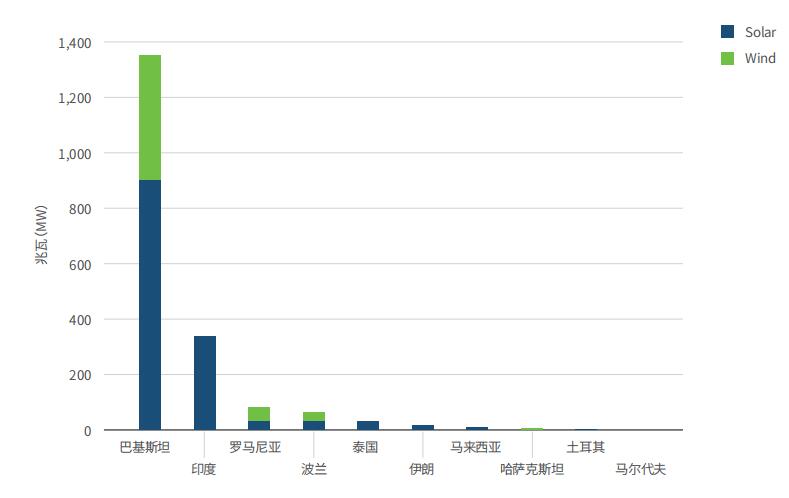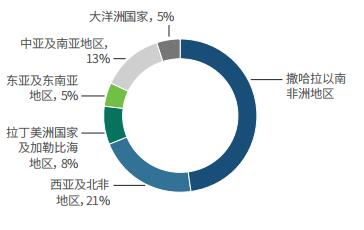"China should formulate clearer and binding green and low-carbon energy investment policies, regulate overseas energy investment standards, promote the development of a green finance policy system, and guide funds to tilt toward the renewable energy sector. China and the countries along the'Belt and Road' Regional governments should work together to promote more comprehensive renewable energy capacity cooperation, not only in the construction of power stations, but in the expansion of upstream and downstream industrial chains, power grids and other infrastructure, so as to better leverage the synergies of renewable energy investment and promote The host country’s economic development, energy transition and social well-being will provide assistance.” Greenpeace suggested.
The positive synergy effect of renewable energy investment is huge
The "Synergy Report" found that with the deepening of the "One Belt One Road" initiative, China's external renewable energy investment will continue to inject impetus into the green and low-carbon development of developing countries. The report estimates the potential of wind power and photovoltaic installations in countries along the “Belt and Road”, predicts China’s investment potential in the region in 2030, and provides a positive impact on China’s participation in countries along the “Belt and Road” from the four dimensions of energy, environment, economy, and society. Quantitative and qualitative analysis was carried out on the co-benefits brought by the investment in wind power photovoltaic projects.

China's investment in wind power and photovoltaics in the form of equity and financing in countries along the “Belt and Road” (as of 2018)
In the five years from 2014 to 2018, Chinese companies have invested approximately 12.04 GW of wind power and photovoltaic installations in 64 countries along the “Belt and Road” in the form of equity investment. The potential of photovoltaic power generation projects will reach 235.41-706.24 GW. Among them, the potential of solar photovoltaic power generation projects is 226.56-679.69 GW, and the potential of wind energy projects is 8.85-26.55 GW.Zhang Jing, head of Greenpeace’s “Green Infrastructure Overseas Investment” project, said: “The cost reduction brought about by technological advancement has made the economics of renewable energy more prominent. In addition to power supply, it is a great opportunity for countries along the “Belt and Road”. Renewable energy investment will also bring about huge positive synergies. It is estimated that by 2030, China's wind power and photovoltaic investment in countries along the'Belt and Road' can bring about 3.715 billion US dollars in economic benefits each year. Among them, the enterprise is the'Belt and Road'. "The main body of project investment and construction, financial institutions are the key links in guiding the green investment of the public and private sectors, and promoting enterprises to fulfill the main responsibility of environmental management. Both play an important role in supporting the development of the green "Belt and Road"."
The "Synergy Report" selects three typical countries that China participates in wind power photovoltaic project investment: Pakistan, Poland, and South Africa for country analysis. It was found that China’s investment in wind power and photovoltaic power in countries along the “Belt and Road” is expected to provide 150-31 million jobs for the host country.
From foreign aid to comprehensive international development cooperation
Foreign aid and international development cooperation are important components of international relations, and they are also one of the important mechanisms for countries to promote the resolution of key global environmental, development, and humanitarian issues on the basis of bilateral and multilateral cooperation. The proposal of the “Belt and Road” initiative laid the institutional foundation for the new paradigm of international development cooperation and promoted the transformation of foreign aid to mutual benefit and win-win international development cooperation. In the field of renewable energy, the integration of South-South cooperation in addressing climate change into the "Belt and Road" initiative and greening and low-carbonization of the "Belt and Road" provide an opportunity for China to promote renewable energy foreign aid and a new paradigm of international development cooperation.

China's renewable energy foreign aid projects are distributed in countries and regions
The "Foreign Aid Report" shows that China's renewable energy aid projects are mainly distributed in Africa and Asia, which are underdeveloped socio-economically developed countries and regions, such as Kenya, Malawi, Uganda, etc. Sub-Saharan African countries and regions accounted for 48% of the total number of projects, followed by Oceania countries, East Asia and Southeast Asia, Central Asia and South Asia.China’s renewable energy foreign aid and international cooperation development are divided into three key stages: 2000-2014, with foreign aid as the mainstay; 2015-2019, further adding new goals and new impetus to address global climate change; 2020 In the future, China's low-carbon transition will enter a period of acceleration, which will fully drive China to play a more active role in the global response to climate change, especially in promoting the transition to clean energy.
Under the impact of the new crown epidemic in 2020, China’s overall investment along the “Belt and Road” has fallen sharply. However, renewable energy investment, especially renewable energy investment involving Chinese state-owned enterprises, has become the focus, and its proportion has surpassed that of fossil energy project investment for the first time.
"China's public funds have a lot of room for development in the proportion and amount of investment in the field of renewable energy. Public funds are an important force in the construction and sustainable development of the green "Belt and Road". Its weak profit-seeking and strong policy orientation , Not only can better complement the private sector capital formation resources, but also play a leading role with one lever." Zhang Jing analyzed.
As the world’s second largest economy and an important link in the international supply chain, the efficiency and quality of China’s economic recovery are critical to promoting sustainable global development. How to better assume the international responsibilities of tackling climate change and help the green rejuvenation of the global economy should become a key area for China to carry out foreign cooperation in the future.
"China should expand public funds to invest in renewable energy projects such as wind power and photovoltaics in countries along the "Belt and Road", optimize and accelerate China’s climate change South-South cooperation mechanism and foreign aid mechanism, and give full play to the leading role of aid funds; policy makers should be China Public funds, especially foreign aid and development finance funds, formulate cleaner and greener standards and green project evaluation systems; explore and implement development financing models such as blended finance, and mobilize more private companies through strategic use of public funds Capital participation to jointly promote sustainable financing support for green projects including renewable energy." "Foreign Aid Report" recommended.
















 RCCN WeChat QrCode
RCCN WeChat QrCode Mobile WebSite
Mobile WebSite